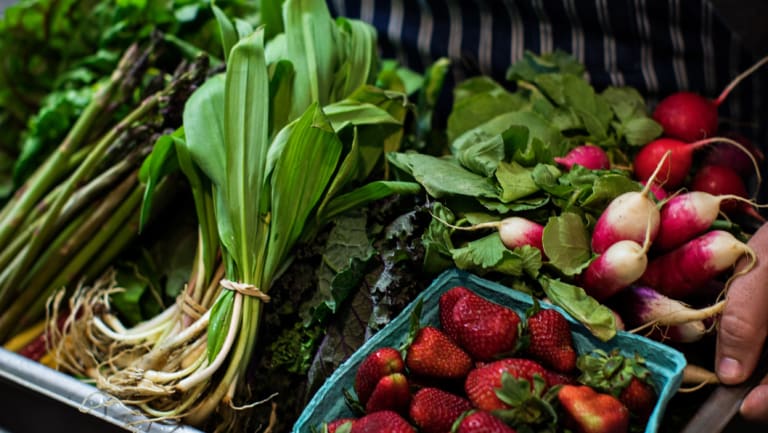Want to get through the Christmas season without ending up with a belly to rival Santa's? While it's near impossible to avoid naughty food at this time of year, there is a simple trick to help you eat healthier now and beyond: eat the rainbow. No, this doesn't mean finding a leprechaun as a dinner companion, it's about consuming a more "colourful" diet.
As Trudy Williams, dietitian at online nutrition portal Foodtalk, explains, "The understanding behind rainbow eating is that foods consumed aren't synthetic, manufactured items or dull-coloured foundation foods such as grains, legumes and meats. Rather they're a colourful mix of fresh fruits and vegetables."
“By eating a colourful range of fresh produce regularly, these phytonutrients work with the cluster of vitamins, minerals and fibre.”Credit:Stocksy
So what benefits does a multicoloured diet offer? Says Williams, "These naturally occurring colours in plant foods indicate the presence of phytonutrients – a plant's inbuilt health-protection system that naturally protects us in similar ways.
"By eating a colourful range of fresh produce regularly, these phytonutrients work with the cluster of vitamins, minerals and fibre found in fruits and vegetables to benefit our health."
As therapeutic agents, phytonutrients play a preventative role by maintaining our immune function. They also have a medicinal effect, helping to reduce inflammation and the risk of cancer while playing a part in bone-density retention and heart protection.
Kate Spina, nutritionist at The Well health centre in Sydney's Bondi, says, "A daily selection of colourful plant foods also offers a wider selection for those who are influenced by the health halo of only greens."
And there is often an unexpected benefit. "It delivers a solid nutrition start for kids who struggle to eat the minimum recommended amount of fruits and vegetables, as colour encourages variety," says Williams.
Here are some colourful fruits and vegetables for good living.
COLOUR ME HEALTHY
Red
The powerful antioxidant lycopene, which gives many red foods their colour, is linked with better heart health and reduced cancer risk, especially prostate cancer. "For maximum benefits, eat them cooked, such as tomato sauces or roasted capsicums," says Spina. "This makes lycopene more easily absorbed by the body and increases its healing capacity."
Contained in: tomatoes, red capsicum, cherries, red apples, watermelon.
Orange
Spina says orange foods are "rich in vitamin C and carotenoids, the orange pigments that convert into vitamin A in our bodies". Our eyesight, immune system, skin health and bone integrity all benefit from these.
Contained in: carrots, sweet potatoes, rockmelon, mangoes, corn, oranges.
Purple
Says Spina, "The rich levels of phytonutrients, notably anthocyanins, in purple and blue vegetables and fruits seem to prevent cardiovascular disease and improve cognitive function." One US study found that compounds in purple potatoes may help kill colon cancer stem cells and limit the spread of the cancer.
Contained in: red grapes, red cabbage, berries, eggplant, plums, blood oranges, beetroot, pomegranates.
Green
Green foods are powerhouses of health. "Chlorophyll, which gives green foods their vibrant hue, reduces the risk of cancer," says Spina. Cruciferous vegetables, such as broccoli, promote intestinal immune function. In turn, the rich levels of vitamin K, lutein and folate present in most green leafy vegies act to keep the brain healthy and slow down cognitive decline.
Contained in: broccoli, spinach, kale, green cabbage, green apples, asparagus, peas, cucumbers, zucchini.
White
The pigment compound quercetin in white foods helps reduce the risk of heart disease and inhibits inflammation and allergy symptoms. Allicin, found in garlic, has antiviral and antibacterial properties which are beneficial to the heart.
Contained in: onions, garlic, leeks, fennel, mushrooms.
This article appears in Sunday Life magazine within the Sun-Herald and the Sunday Age on sale December 2.
Source: Read Full Article
